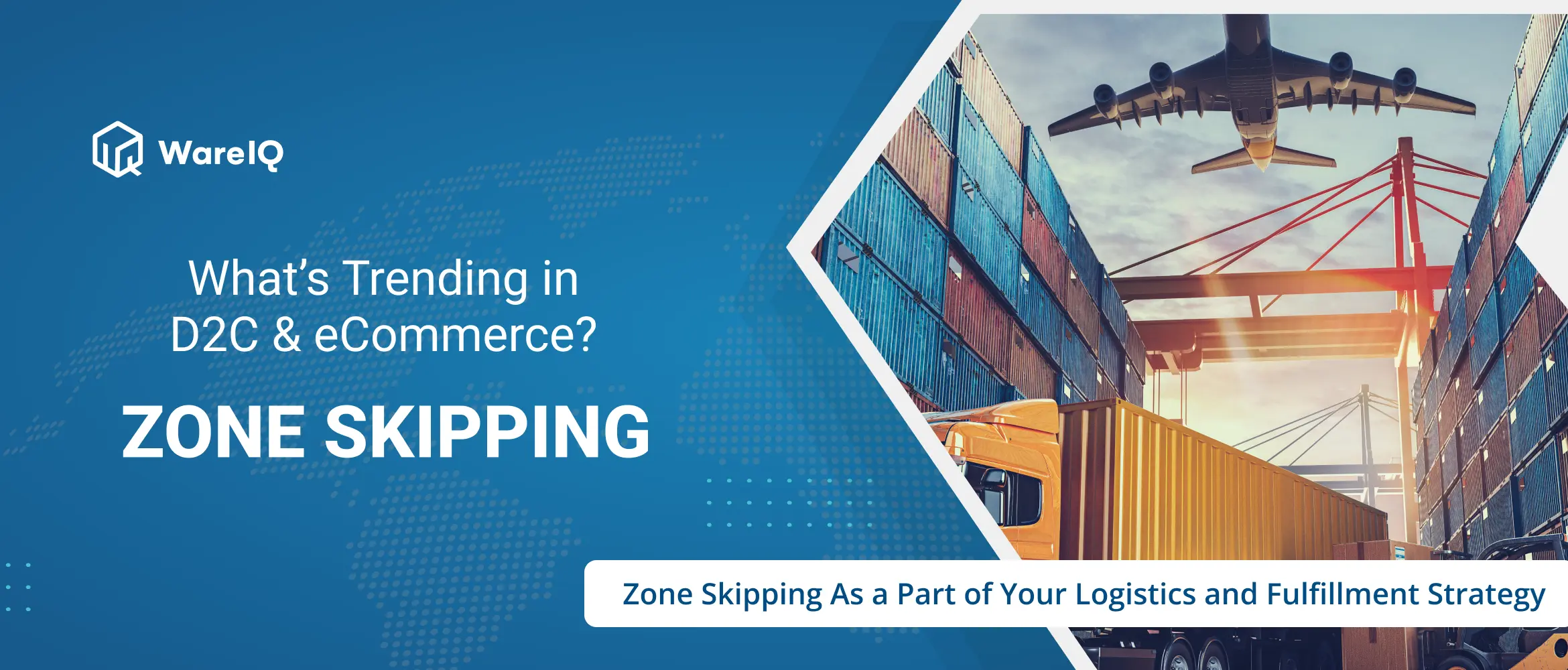
When and Why Should Zone Skipping Be a Part of Your Logistics and Fulfillment Strategy?
Zone skipping has become an increasingly popular logistics strategy for businesses looking to reduce shipping costs and improve delivery times. According to a study by the National Retail Federation, nearly 60% of retailers surveyed used zone skipping in their shipping operations.
One reason for the popularity of zone skipping is the increasing complexity of global supply chains. With more and more businesses sourcing materials and products from around the world, shipping costs can quickly add up. By bypassing certain shipping zones or regions, businesses can often find more direct and efficient routes, resulting in significant cost savings.
For example, a business that ships products from Asia to the United States might traditionally use ground transportation to move the goods across the Pacific Ocean. However, by using air or ocean shipping instead, the business could potentially save thousands of dollars in shipping costs and reduce transit times by several days.
Definition of Zone Skipping in Logistics
Zone skipping in logistics refers to the practice of bypassing certain shipping zones or regions in order to reduce shipping costs or transit times. This can be done by using a more direct or efficient routing, such as by utilizing air or ocean shipping rather than ground transportation, or by using a third-party logistics provider that has established relationships and negotiated rates with carriers in specific regions.
Zone skipping can effectively reduce shipping costs and improve delivery times, especially for businesses that ship large volumes of goods over long distances or to multiple countries. However, it can also involve additional logistical challenges, such as coordinating with multiple carriers and customs agencies, and may not be feasible for all shipments.
“Large marketplaces like Amazon & Flipkart efficiently do Zone Skipping to lower their net logistics cost while delivering parcels at fast speed with low returns. Zone skipping refers to a shipping method in which a package is shipped to a location in a different zone from the intended destination, with the intention of reducing shipping cost and improving speed.
Last-mile comprises 60-80% of the total logistics cost for most of the brands. So efforts to reduce this cost component derives maximum savings in the value-chain. In India logistics, Zone categorization works as follows: Zone A & B are local and regional zones while Zone C & D are metros & national shipping zones respectively. There is a huge difference in cost & speed between the zones, and RTO (returns) %.”
– Harsh Vaidya, CEO & Co-Founder, WareIQ
Impact of Zone Skipping
Zone skipping can have several impacts on businesses and their supply chains, both positive and negative. Some potential impacts include:
Cost Savings
One of the primary benefits of zone skipping is the potential for cost savings. By bypassing certain shipping zones or regions and utilizing more direct or efficient routing, businesses can save thousands of dollars in shipping costs.
Improved Delivery Times
Zone skipping can also lead to faster delivery times, allowing businesses to bypass congested or slower-moving shipping lanes and utilize more efficient routing. This can be especially important for businesses that rely on the timely delivery of goods to meet customer demand or production schedules.
Increased Complexity
However, implementing a zone skipping strategy can also add complexity to a business’s supply chain. Coordinating with multiple carriers and customs agencies can be time-consuming and may require additional resources. In addition, businesses must carefully evaluate the reliability and reputation of carriers to minimize the risk of damage or loss during transit.
Environmental Impact
Another potential impact of zone skipping is its potential environmental impact. By using more efficient or direct routing, businesses may be able to reduce their carbon emissions and other environmental impacts. However, air or ocean shipping may also have a larger environmental impact than ground transportation.

“To illustrate this with math, consider the following for a parcel to be shipped to Bangalore:
➡️Shipping from NCR to Bangalore (Zone C Shipment), would typically cost, say INR 50/shipment (500 gms) by Air and would take 48 hours
➡️Shipping this locally within Bangalore (Zone A Shipment) would cost INR 30/shipment and would take 24 hoursThis brings a savings of INR 20/shipment in last-mile delivery. Assuming fulfillment costs (storage, pick & pack) being the same in both the locations, the incremental cost would be first-mile cost & excess inventory holding cost. In our experience, this would blend to ~ INR 8/shipment
This would lead to a saving of INR 12/shipment overall with an improvement in speed by 1 day. For a business with 3,000 orders/month, this translates to savings of INR 36,000 per month or INR 4,32,000 per year.
Zone skipping also help in reducing returns. When an order is shipped directly to the customer, there is less opportunity for the item to be damaged or lost in transit. Additionally, by reducing the distance that orders have to travel, businesses can reduce the risk of delays or other issues that can lead to customer dissatisfaction and returns.
As per our data, Zone D RTOs are 3 times of Zone A, and 2 times of Zone B. This not only adds to your cost, but dramatically impacts your future repeat purchases in the Zone.
It’s important to note that zone skipping may not always result in a cost benefit, as the cost of inventory holding & first-mile may overshoot the savings if not done right. In this case, a brand would be buying the fast-shipping experience without the savings.
As an intelligent fulfillment network, WareIQ helps brands with real-time insights on Zone Skipping, and create inventory plans to lower holding costs. Further, we have daily stock replenishments running between our FCs across the zones leading to efficient transfers at low cost. All done seamlessly through a centralized platform.”
– Harsh Vaidya, CEO & Co-Founder, WareIQ
When to consider Zone Skipping?
An eCommerce company should consider zone skipping when:
- High Shipping Costs: Zone skipping involves shipping products directly from the manufacturer or supplier to the customer, bypassing the company’s warehouse or distribution center. This can result in lower shipping costs as the products are not being shipped twice.
- Demand concentrated in certain zones: If there is high demand for products in certain regions, zone skipping can eCommerce players meet demand more efficiently by shipping products directly to those regions.
- Long lead times: In case of long lead times, zone skipping can help to reduce the lead time by shipping products directly from the manufacturer or supplier.
- Limited warehouse capacity: Zone skipping can help brands to manage inventory more efficiently in case of limited warehousing capacity by shipping products directly to customers.
- Improving customer experience: Zone skipping can improve the customer experience and increase customer satisfaction by reducing shipping time and costs.
Conclusion
Zone skipping can help modern Indian eCommerce by placing inventory closest to customers, thus lowering shipping costs and boosting delivery times. This can also help companies manage their inventory more efficiently and meet high demand in certain regions.
However, it’s important to note that zone skipping comes with its own complexities, such as compliance with laws and regulations, communication with suppliers and manufacturers, managing inventory and forecasting demand.
Therefore, it is important to put this into action with a trusted 3PL that possesses the aforementioned capabilities of generating sharp data insights regarding your supply chain, has a smart fulfillment platform for easily placing your inventory at the right location, and has designed a refined people and process approach is well-aligned with your business goals and objects and makes zone skipping as a strategy seamlessly possible.
- Pan India Fulfillment & Darkstore Network: Plug-and-play fulfillment infrastructure with no minimums, which is compliant with Amazon Seller Flex, Flipkart Assured, Myntra and other marketplaces
- Inventory & Network Planning Excellence: Best-in-class AI models for sales forecasting, product segmentation, and inventory management to reduce inventory by 40% and increase revenue by 10%.
- Vertically Integrated Fulfillment Tech Stack: Our Fulfillment Tech Solution supports integrations with 20+ top marketplaces & D2C platforms, and prominent national, regional and hyperlocal couriers, enhancing reach by covering deliveries for 27,000+ pin codes
- Supply Chain Productivity Applications: Integrate a host of supply chain productivity apps with a single-click to your existing CRMs, ERPs & accounting software to manage your logistics workflows from one command center. Use Apps like RTO Shield to get 100% RTO protection, Branded Tracking to turn your order tracking page into a profitable marketing channel, and many more.
Trusted by 300+ top Indian brands, we are helping them accelerate online sales and expedite their growth through a synergistic combination of advanced technology, robust fulfillment infrastructure & seller enablement services!WareIQ is backed by leading global investors including Y Combinator, Funders Club, Flexport, Pioneer Fund, Soma Capital, and Emles Venture Partner.







